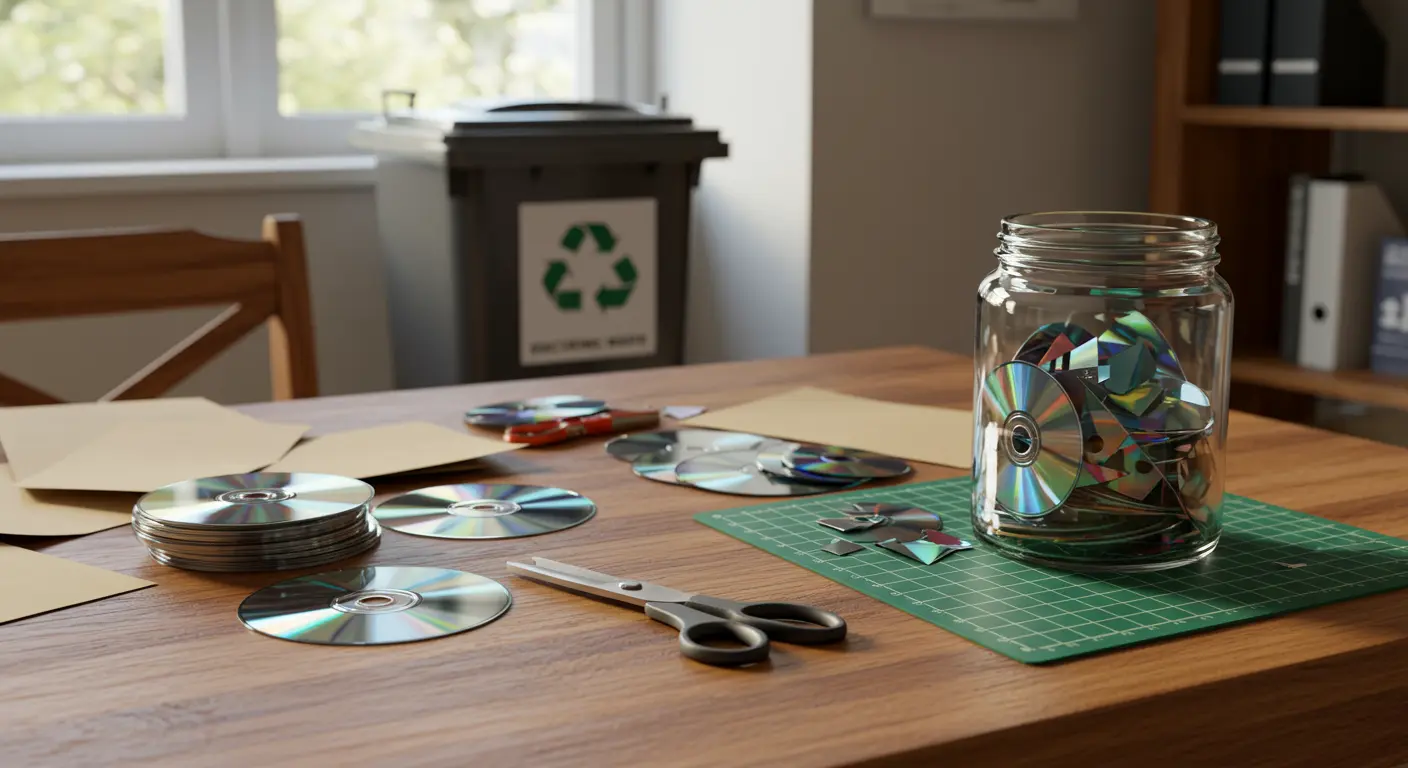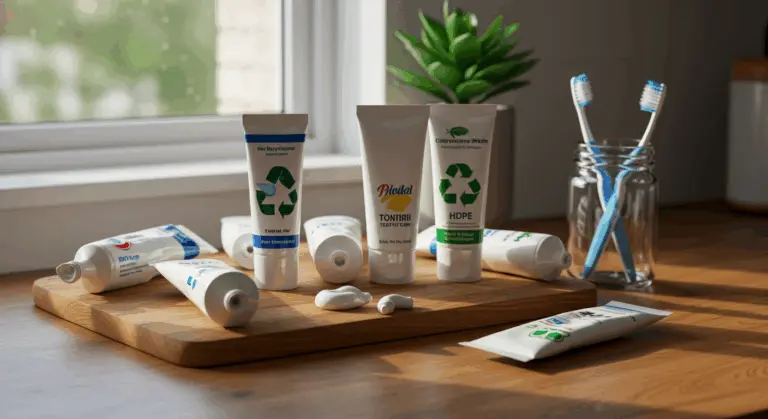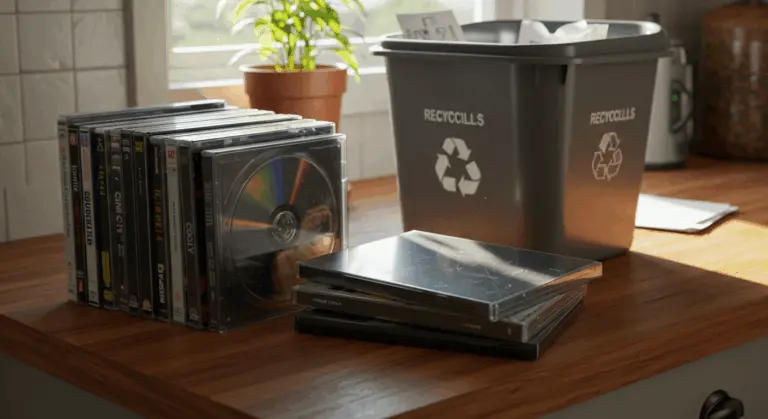Understanding the Recycling Process for CDs
CDs present a fascinating recycling puzzle due to their complex composition. Each disc contains a blend of polycarbonate plastic, a thin aluminum layer, and occasionally trace amounts of gold in premium editions. This multi-layered architecture makes conventional recycling methods ineffective, keeping them out of from standard recycling streams.
The environmental impact is significant. When improperly disposed of in landfills, CDs can take up to 400 years to decompose. During this lengthy breakdown period, they potentially release harmful chemicals, including bisphenol A (BPA), which can contaminate soil and water sources. One disc may appear trivial. Yet with billions manufactured since the 1980s, their collective environmental footprint is immense.
Specialized CD recycling uses advanced processes where discs undergo initial shredding before component separation. The polycarbonate plastic—comprising roughly 99% of each disc’s weight—can be reclaimed and transformed into automotive parts, office equipment, or fresh optical media. Meanwhile, the aluminum layer, though minimal per disc, accumulates significant value when processed en masse.
By directing your unwanted CDs to these proper channels, you’re not only preventing pollution but also conserving the raw materials and energy that would otherwise be required to produce new products from scratch. → Sending unwanted CDs to these channels prevents pollution and conserves the raw materials and energy required to make new products.
Options for Recycling or Disposing of CDs
When clearing out your CD collection, several eco-friendly options exist beyond throwing them away. Each strategy delivers distinct advantages, depending on your discs’ condition and personal values.
Working CDs can find new homes through donation or resale:
-
Donation: Offer your collection to libraries, schools, senior centers, or thrift stores. These organizations give your collection new life while enriching the community.
-
Resale: Sell your collection to used media stores or online via marketplaces like eBay, Discos, and Music Magpie, especially for sought-after titles.
When CDs are damaged or obsolete, specialized recycling becomes the best option. The CD Recycling Center of America accepts shipments of unwanted discs for proper processing, ensuring the materials are handled responsibly. Many electronic waste facilities and certain municipal recycling programs also accept CDs as part of their plastic media or e-waste collection services. Before shipping or dropping off your discs, check with the facility about any preparation requirements, such as removing paper inserts or separating jewel cases. → For damaged or obsolete CDs, specialized recycling is the best choice. Services like the CD Recycling Center of America or local e-waste facilities accept them. Before sending, check their specific preparation requirements, such as removing paper inserts or separating jewel cases.
Creative people can repurpose worn discs into many useful items:
-
Mosaic art pieces
-
Garden decorations to deter birds
-
Unique coasters
-
Custom wall art
If you’re unsure which path to take, community sharing platforms like Buy Nothing, Free cycle, or neighborhood social media groups provide a way to gauge interest in your collection before committing to recycling. Someone in your community might treasure what you no longer need, creating the most efficient form of recycling – direct reuse. → Community sharing platforms like Buy Nothing or Free cycle are perfect for direct reuse, connecting you with local people who may want your collection.
Creative Ways to Repurpose Old CDs
When recycling isn’t an option, transforming old CDs into creative projects gives these shimmering discs new life while keeping them out of landfills. The reflective surface of CDs makes them perfect for DIY crafts that add sparkle and visual interest to your home or garden. With just a few basic tools, your outdated media can become eye-catching decorative pieces. → The reflective surface of old CDs makes them ideal for various DIY projects, giving the discs a new purpose while keeping them out of landfills.
In gardens, CDs work well as bird deterrents when suspended from trees or structures. Their reflective surfaces capture sunlight, creating moving patterns that naturally keep birds away from plants and produce. String multiple discs together for a shimmering curtain effect, or position them strategically to protect specific garden areas while adding visual appeal.
For indoor projects, you can slice CDs into fragments (with appropriate safety gear) to craft breathtaking mosaic designs on picture frames, flowerpots, or decorative boxes. CD fragments have a unique iridescent quality that catches light differently than regular mosaic tiles, creating an effect that changes as you move. These pieces can be adhered with standard craft glue to transform ordinary objects into conversation pieces.
Practical applications abound: intact CDs make excellent drink coasters when paired with felt or cork backing to prevent surface scratches. Transform them into striking wall clocks with simple mechanisms, or craft festive ornaments using permanent markers, glitter, and embellishments. Advanced crafters can carefully heat and mold CDs into sculptural bowls or distinctive jewelry pieces.
Children’s craft projects offer another fun way to repurpose CDs. With supervision, kids can create sun catchers, robots, fish scales, or even miniature disco balls using old discs. Beyond sparking creativity, these projects teach valuable lessons about material reuse over disposal. This helps children develop environmental awareness from a young age.
The Role of Green Disk in Electronic Media Recycling
Green Disk is a leader in electronic media recycling, dedicating over three decades to responsible disposal solutions for obsolete technology. Born from a mission to tackle escalating electronic waste challenges, this company has developed specialized processes for media—CDs, DVDs, floppy disks—that conventional recyclers routinely reject.
What sets Green Disk apart is their comprehensive approach to electronic media recycling. Unlike standard recycling facilities, they have the specialized equipment needed to separate the various components of CDs—including the polycarbonate plastic, aluminum layer, and lacquer coating—ensuring each material enters the appropriate recycling stream. → What sets Green Disk apart is its specialized equipment that separates CD components—polycarbonate plastic, aluminum, and lacquer—to ensure each material is properly recycled.
Their innovative Techno trash program serves diverse clientele:
-
Individuals: Can order pre-paid recycling boxes online for shipping smaller quantities of media.
-
Businesses: Can use bulk recycling services that include certified secure data destruction.
Beyond material processing, Green Disk promotes environmental education and transparency. They explain their recycling methods and environmental standards, helping consumers understand proper electronic media disposal’s significance. Their digital platform provides detailed resources explaining the environmental impact of electronic waste while offering guidance for decluttering our increasingly digital existence.
Choosing Green Disk for CD recycling connects consumers to a circular economy where obsolete media materials are reused in new manufacturing. This reduces the need for virgin resource extraction and keeps these materials from entering landfills. For conscientious individuals seeking responsible CD disposal, Green Disk offers one of North America’s most comprehensive and environmentally responsible solutions.
Educational Programs on Recycling and Waste Management
Educational programs targeting recycling and waste management are essential for building sustainable communities and environmental stewardship. These initiatives bridge critical knowledge gaps between daily actions and their ecological consequences—particularly regarding specialized items like CDs and electronic media.
Many states and municipalities have developed comprehensive educational frameworks that teach citizens about the complete lifecycle of waste materials. For example, Massachusetts has implemented programs that explain what happens to trash and recyclables after they leave homes and businesses. These programs highlight ways to reduce waste generation at the source, improve recycling habits, and make small but impactful lifestyle changes that contribute to sustainability goals. → Many local governments have educational frameworks, like those in Massachusetts, that teach the lifecycle of waste. These programs promote reducing waste at the source, improving recycling habits, and making sustainable lifestyle changes.
Schools and universities have excellent opportunities to lead recycling initiatives. Schools, colleges, and universities can establish collection programs specifically for electronic media like CDs, partnering with local recycling facilities or specialized services like Green Disk to ensure proper disposal. They can also engage manufacturer take-back programs, establishing accessible collection hubs for their communities.
Education goes beyond just collection. Effective programs incorporate hands-on learning experiences, such as facility tours that show students exactly how recycling processes work. Some schools integrate electronic waste topics into their curriculum, explaining why proper CD disposal matters within broader conservation contexts.
Corporate training programs improve recycling effectiveness. Companies offer training sessions teaching proper sorting techniques and emphasizing why electronic media must avoid conventional waste streams. These programs feature visual guides and explicit instructions about recyclable versus non-recyclable materials, emphasizing specialized recycling needs for items like CDs.
Community workshops are effective educational tools that provide practical knowledge about consumption reduction, creative reuse, and proper recycling. These interactive sessions can demonstrate creative repurposing ideas for CDs while also explaining the environmental benefits of proper waste management. Combining practical tips with environmental education helps people make better waste management choices.




